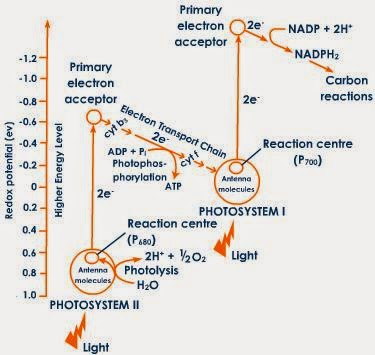- Photosynthesis:
It is a physic-chemical process by which green plants and some other organism use light to synthesise organic compounds. It is the primary source of food for all living organism and green plants release oxygen into the atmosphere.
SITE OF PHOTOSYNTHESIS
It takes place in the cell organelles, called chloroplasts, which are found in the mesophyll cells of leaves.
There is a clear division of labour within the chloroplasts
The membrane system is responsible for the photochemical phase where
synthesis of NADPH and ATP takes place. The stroma has enzymes for the reduction of carbon dioxide into
carbohydrates and formation of sugars.
A chromatographic separation of the leaf pigments shows that there are four pigments: chlorophyll a, chlorophyll b, carotene and xanthophyll.
Chlorophyll a is the main pigment associated with photosynthesis, while chlorophyll b, and carotenoids act as accessory pigments. The accessory pigments help firstly they absorb light at differentwavelengths and pass it on to the chlorophyll a. Secondly they also protect the chlorophyll from photo oxidation.
PHOTO SYSTEMS:
The pigments are organised in the thylakoid membranes into two discrete
light harvesting complexes (LHCs) within photosystems, photosystem I (PS I)
which is a chlorophyll a molecule that absorbs light at 700 nm. and photosystem
II (PS II) a chlorophyll a molecule that absorbs light at 680 nm. Each photosystem has one specific chlorophyll a and many other pigments
bound by proteins. The chlorophyll a forms the reaction centre, where the
actual reactions take place, while the other pigment molecules form the light
harvesting system, also called antennae.
Light reaction or photochemical
phase
Electron transport (ATP
synthesis) and photolysis are the two major events in light reactions.
During this phase, water is split (photolysis) and oxygen is liberated.
ATP and NADPH formed in this phase are used up during the biosynthetic
phase (dark reaction)
The photolysis of water:
It is the process in which water is split into protons, electrons and
oxygen.
The water splitting complex is associated with photosystem II, which is
located on the inner side of the thylakoid membrane.
The electrons are used to replace the electrons lost by PS II.
The oxygen is liberated into the atmosphere while the protons accumulate
in the lumen of thylakoids.
ELECTRON TRANSPORT:
The scheme of electron transport starting from PS II, uphill to primary
electron acceptor, downhill to cytochrome complex and PS I, excitation of PS I,
transfer of electrons uphill to another acceptor and finally downhill to NADP ,
is called Z-scheme, because of the characteristic shape,Z, formed when all the carriers are placed in a sequence according to their redox potential values.
When both photosystems II and I work in a series, as shown in figure
above then it is termed as Z-scheme, it is called non-cyclic photophosphorylation. During this cycle both ATP and NADPH are formed during this electron flow
and the electrons lost from PS II do not return to PS II, but are replaced by
those from water.
But when only PS I is functional, the electrons are circulated within PS I and phosphorylation occurs within the cyclic flow so it is termed as cyclic photophosphorylation. This happens in the stroma lamellae, which lacks PS II and NADP-reductase enzyme as shown in figure.
Since the splitting of the water molecules or photolysis takes place on the inner side of the thylakoid membrane, the protons produced accumulate within the lumen of the thylakoids.











No comments:
Post a Comment